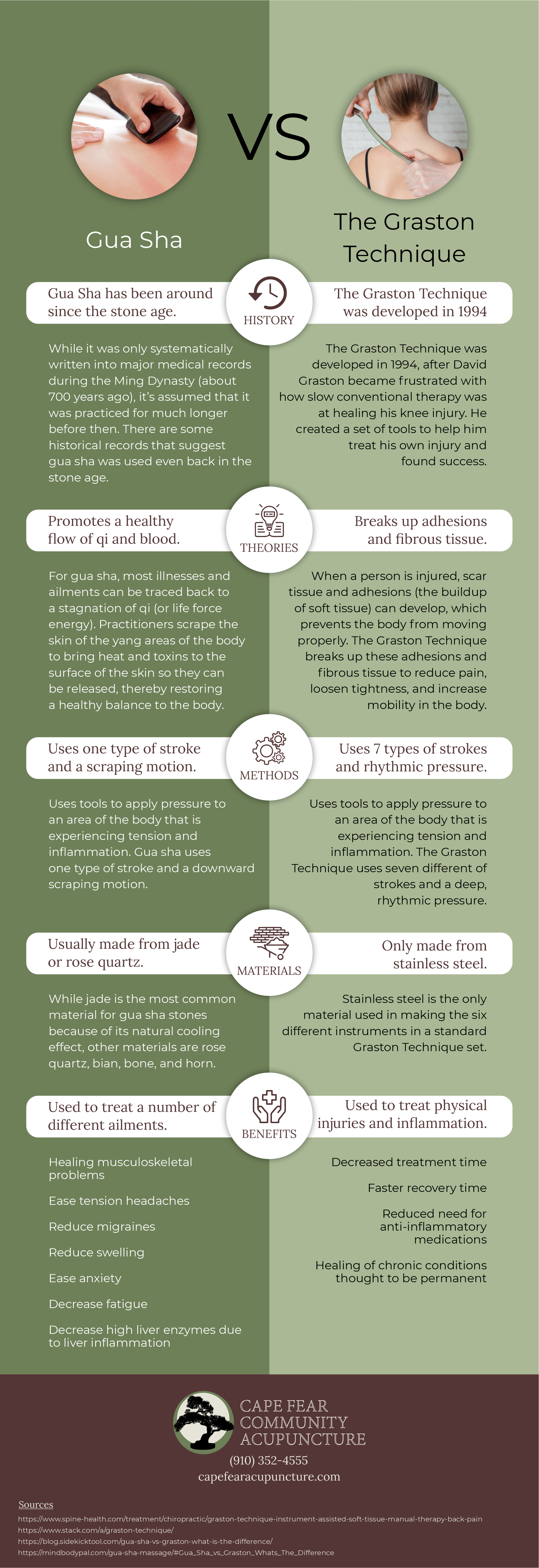The Differences Between Gua Sha and the Graston Technique [Infographic]
Here at Cape Fear Community Acupuncture, we offer facial gua sha after our cosmetic acupuncture sessions, and we’ve gotten a few people curious as to the difference between gua sha and the Graston Technique since they both look very similar. Today we’ll be going over the similarities and differences.
History of the Techniques
Gua sha has been around for a very long time. While it was only systematically written into major medical records during the Ming Dynasty (about 700 years ago), it’s assumed that it was practiced for much longer before then. There are some historical records that suggest gua sha was used even back in the stone age.
The Graston Technique was developed in 1994 in Indiana after David Graston, who suffered a severe knee injury, became frustrated with how slow conventional therapy was at healing his injury. Since he had a background in machining, he decided to create a set of tools to help him treat his own injury. He found success with his tools and techniques and decided to collaborate with personnel at Ball Memorial Hospital.
Underlying Theories
While both treatments aim to bring relief to painful areas of the body, the underlying theories behind them vary greatly. For gua sha, most illnesses and ailments can be traced back to a stagnation of qi (or life force energy). In order to promote a healthy flow of qi and blood, practitioners scrape the skin of the yang areas of the body (i.e. back, shoulders, neck, butt, etc.) to bring heat and toxins to the surface of the skin so they can be released, thereby restoring a healthy balance to the body.
When a person is injured, scar tissue and adhesions (the buildup of soft tissue) can develop, which prevents the body from moving properly. The Graston Technique breaks up these adhesions and fibrous tissue to reduce pain, loosen tightness, and increase mobility.
Methods
While the underlying theories behind gua sha and the Graston Technique may be very different, they have very similar methods of practice. Both gua sha and the Graston Technique use tools to apply pressure to an area of the body that is experiencing tension and inflammation. This pressure reduces the pain and inflammation and promotes healing in the area. However, gua sha only uses one type of stroke and a scraping motion while the Graston Technique uses seven different types of strokes and more of a deep, rhythmic pressure.
Both treatments also bring about similar reactions in the skin. For both gua sha and the Graston Technique, the most common side effect is redness, bruising, and petechiae (small, red rash-like spots) on the treated area of the skin.
Both gua sha and the Graston Technique have been shown to create micro traumas, which actually promotes proper healing of the tissue and muscle.
Materials Used
For gua sha, there is a lot of flexibility when it comes to what materials can be used:
- Jade
- Rose quartz
- Bone
- Horn
- Bian
- Wooden spoons
Jade is considered the most common material for gua sha stones because it is a naturally cooler stone that helps reduce swelling or puffiness in the skin. Materials like bone and horn are much less common nowadays, though they were readily available materials when gua sha first came about.
For the Graston Technique, only stainless steel is used in the standardized set of tools. These tools are specially designed for the clinician to feel and isolate adhesions in the injured area more accurately and easily than with palpation alone. There are six different types of instruments with various curves and edges that conform and correspond to the contours of different parts of the body.
Benefits
Gua sha is used to treat a number of different common ailments and illnesses, including:
- Musculoskeletal problems
- Tension headaches
- Migraines
- Swelling
- Anxiety
- Fatigue
More studies are being done on the benefits of gua sha, and in one case study, a man with high liver enzymes (an indicator of liver inflammation) received a gua sha treatment and afterwards experienced a decline in his liver enzymes. This suggests that gua sha can help treat liver inflammation, such as that caused by Hepatitis B.
The Graston Technique is used to treat injuries of soft tissue and has a number of benefits such as:
- Decreased treatment time
- Faster recovery
- Reduced need for anti-inflammatory medication
- Healing of chronic conditions thought to be permanent
Ready for your cosmetic acupuncture and gua sha service? Click here to book your appointment!

